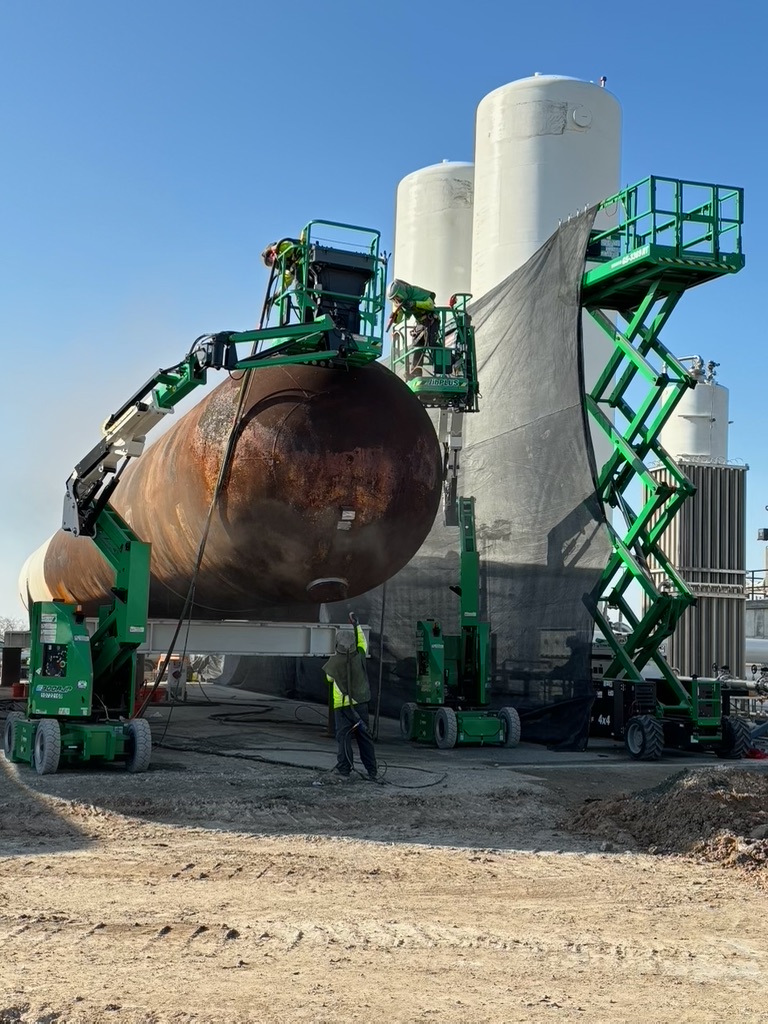The Evolution and Maintenance of Silos and Tanks
THE HISTORY OF SILOS AND TANKS
 The history of silos and tanks is quite fascinating, as these structures have played an important role in agriculture and infrastructure development. The concept of storing grains or other materials in containers dates back thousands of years, but the modern silos and tanks we see today have evolved significantly over time. In fact, the earliest forms of silos can be traced back to ancient civilizations, such as the Egyptians, Greeks, and Romans who used underground pits or simple above-ground structures to store grains and other food.
The history of silos and tanks is quite fascinating, as these structures have played an important role in agriculture and infrastructure development. The concept of storing grains or other materials in containers dates back thousands of years, but the modern silos and tanks we see today have evolved significantly over time. In fact, the earliest forms of silos can be traced back to ancient civilizations, such as the Egyptians, Greeks, and Romans who used underground pits or simple above-ground structures to store grains and other food.
So what are silos and tanks, and what are they used for? Silos are primarily used for storing dry bulk materials like grains and powders, while tanks are used for storing liquids, gases, and semi-solid substances. Both silos and tanks are important components of storage infrastructure in agriculture, manufacturing, and various industrial industries, helping to maintain supply chains, manage inventory, and ensure the efficient use of resources.
THE ROLE OF SILOS IN THE AGRICULTURE INDUSTRY
Silos provide farmers and agricultural businesses with a means to store large quantities of grains and seeds after harvest. By storing crops in silos, farmers can protect them from spoilage, pests, and environmental factors such as moisture and temperature changes. This helps ensure a steady supply of grains throughout the year, even during periods of low production or market demand.
Cargill is one of the largest agricultural commodity traders and processors globally, with operations in grain storage, handling, and distribution. The company operates numerous grain elevators, silos, and storage facilities worldwide to support its trading and processing activities.
ADM is a leading agricultural processing company involved in the production of food ingredients, animal feed, and biofuels. The company operates a vast network of grain elevators, storage silos, and processing plants to handle and store grains such as corn, soybeans, and wheat.
These companies, along with many others in the agriculture industry, rely on silos to store and manage grains and other foods efficiently, ensuring supply chain resilience and market competitiveness.
THE ROLE OF TANKS IN THE ETHANOL INDUSTRY
Many companies in the ethanol industry rely on ethanol tanks as essential infrastructure for the storage, transportation, and distribution of ethanol, which is used as a renewable fuel additive and a component in ethanol-blended gasoline. Ethanol tanks play a vital role in ensuring the availability and accessibility of ethanol-based fuels to consumers while supporting the growth of the renewable fuels industry.
POET is one of the world's largest ethanol producers, with numerous ethanol plants across the United States. The company relies on ethanol tanks for storing ethanol produced from corn at its ethanol production facilities. These tanks are crucial for maintaining an inventory of ethanol and facilitating its distribution to fuel terminals, where it is blended with gasoline.
SANDBLASTING FOR SILO & TANK MAINTENANCE
 Blast It Clean uses abrasive blasting for maintaining silos and tanks for several reasons, including surface preparation. Sandblasting makes quick work of rust, corrosion, old paint, and any other stubborn contaminants clinging to the surface. After sandblasting, you are left with a clean base which helps coatings adhere better and will make them last longer.
Blast It Clean uses abrasive blasting for maintaining silos and tanks for several reasons, including surface preparation. Sandblasting makes quick work of rust, corrosion, old paint, and any other stubborn contaminants clinging to the surface. After sandblasting, you are left with a clean base which helps coatings adhere better and will make them last longer.
Over time, silos and tanks can develop rust and corrosion due to exposure to moisture, chemicals, and environmental factors. Sandblasting effectively removes rust and corrosion from metal surfaces, restoring them to a smooth and rust-free condition. By blasting away the rusty patches and rough spots, you're not just making your silo or tank look better - you're actually helping to extend its lifespan.
Silos and tanks may accumulate debris, scale, and other contaminants over time, which can affect their performance, strength, and reliability. Sandblasting provides a thorough and efficient cleaning method for removing stubborn deposits and restoring the surface to its original condition. This helps maintain cleanliness, prevents contamination of stored materials, and prolongs the lifespan of the structure.
The best part is that sandblasting is surprisingly gentle on your silo or tank. Unlike some other cleaning methods that can be rough on the surface, sandblasting gets the job done without causing any damage to the underlying substrate. So you can rest easy knowing that your storage buddy is in good hands.
WHAT COATINGS SHOULD BE USED FOR SILOS AND TANKS?
The choice of coating for silos and tanks depends on several factors including the material of construction, the contents being stored, environmental conditions, and regulatory requirements. Some of our most commonly used coatings are included below.
 Epoxy coatings are widely used for their excellent chemical resistance and adhesion properties. They are suitable for both interior and exterior surfaces and are often used in food processing, water treatment, and chemical storage tanks.
Epoxy coatings are widely used for their excellent chemical resistance and adhesion properties. They are suitable for both interior and exterior surfaces and are often used in food processing, water treatment, and chemical storage tanks.
Waterproof membranes, or polyurethane coatings, offer good abrasion resistance and durability, making them suitable for tanks subjected to mechanical wear and tear. They are also resistant to a wide range of chemicals, making them suitable for various industrial applications.
Polyurea coatings are known for their fast curing time and high chemical resistance. They form a seamless, impermeable barrier that provides excellent protection against corrosion and abrasion. Polyurea coatings are often used in industrial settings where quick turnaround times are required.
Zinc coatings, such as zinc-rich primers or hot-dip galvanizing, are used to provide corrosion protection to steel silos and tanks. These coatings are particularly effective in outdoor environments where the structures are exposed to moisture and atmospheric corrosion.
SILOS & TANKS PROJECTS WITH BLAST IT CLEAN
POET - ETHANOL TANK FARM CLEANING
One of our biggest ethanol tank projects we tackled was with Poet. In the process of restoring the tank, we came across a series of unique challenges that demanded innovative solutions. One of the primary hurdles we faced was the tank's tendency to "sweat" due to fluctuating water temperatures, especially during hot summer days. This presented a requirement for a coating solution that could effectively adhere to a surface with existing moisture. Our project timeline was strategically planned during the spring season, making sure we finished before the onset of scorching summer temperatures.
In response to these challenges, we utilized a specialized coating that had the ability to cure effectively despite surface moisture. This ensured a secure and durable bond, laying the groundwork for a protective layer that would withstand the test of time. With the tank's considerable size, we used the man lift to get every nook and cranny, breaking it down into top and bottom sections to keep things manageable.
The final touch in our restoration endeavor was the application of a UV-resistant topcoat, selected to enhance both visual appeal and durability. Not only did it make the tank look sharp, but it also shielded it from the sun's harsh rays, keeping those colors popping for years to come.
TOTAL ENERGY - BLASTING & PAINTING 3 TANKS
 Recently Blast It Clean had the chance to work with Total Energy on three 13,000 sqft tanks in Brownsville, Texas. We started with the exterior, making sure containment measures were in place. Picture two massive barrier walls standing tall at 27 feet and stretching 60 feet wide. They're like the superheroes of the site, protecting both passersby and workers from any blasting or painting action. We then sandblasted and finished up with 2 coats of epoxy, and 1 coat of acrylic polyurethane.
Recently Blast It Clean had the chance to work with Total Energy on three 13,000 sqft tanks in Brownsville, Texas. We started with the exterior, making sure containment measures were in place. Picture two massive barrier walls standing tall at 27 feet and stretching 60 feet wide. They're like the superheroes of the site, protecting both passersby and workers from any blasting or painting action. We then sandblasted and finished up with 2 coats of epoxy, and 1 coat of acrylic polyurethane.
For the interior, their tanks received a blasting preparation and a coating application using PHENICON HS. This high-tech epoxy ensures the tanks stay protected from the inside out, meeting the gold standard for quality and safety.
At Blast It Clean, we are always more than happy to help. If there's a project that falls outside our expertise, no sweat! We'll gladly steer you toward the right folks who can. Do you have a tank or silo that needs sandblasting and/or painting? Call Blast It Clean for stripping, cleaning, and painting.
